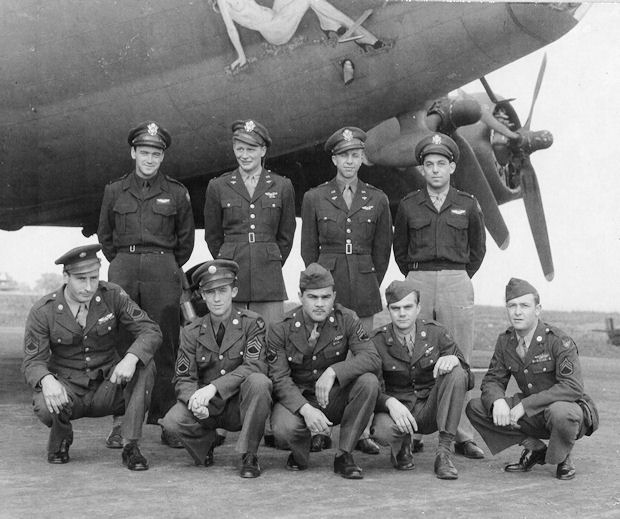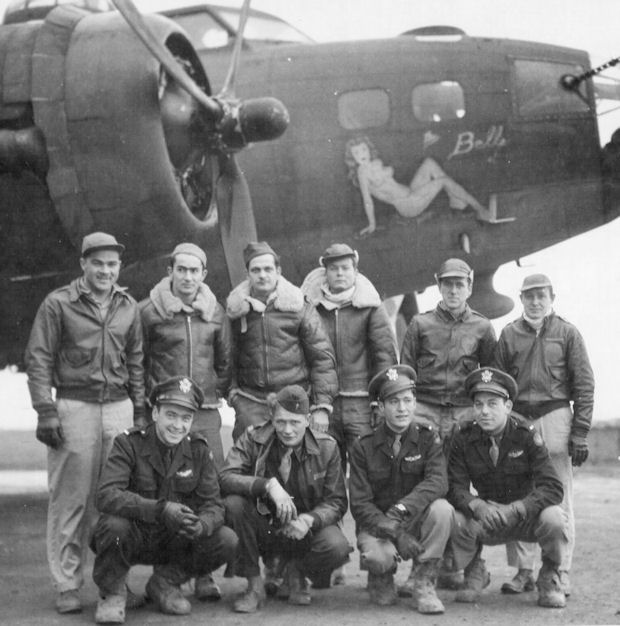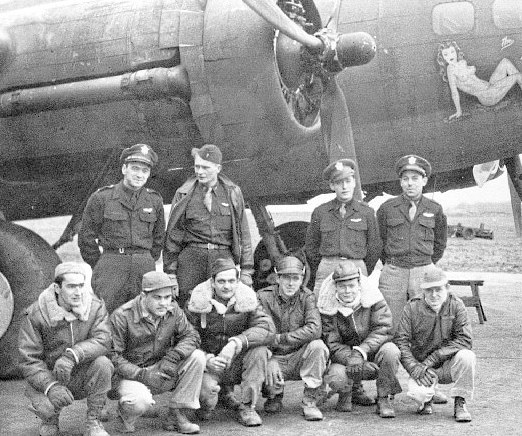 |
360th Bergeron Crew Willard H. Bergeron, Pilot |
Personnel
Mission Reports

WILLARD H. BERGERON CREW - 360th BS
(crew assigned 360BS: 25 July 1943 - photo: 16 Oct 1943)
(Bergeron was copilot to L.E. Jokerst, upgraded to pilot 10 Oct 1943)
(Back L-R) Capt Willard H. Bergeron (P), 1Lt Hershel R. DeWall (CP),
1Lt James B. Noland (N), 2Lt Robert N. DeFeis (B)
(Front L-R)
S/Sgt George W. Wilson (WG),
S/Sgt Simon Oxendine (BT),
T/Sgt Alphonse B. Serwa (E),
T/Sgt Leroy Cline (R),
S/Sgt Vernon R. Appleton (TG)

WILLARD H. BERGERON CREW - 360th BS
(crew assigned 360BS: 25 July 1943 - photo: 16 Oct 1943)
(Bergeron was copilot to L.E. Jokerst, upgraded to pilot 10 Oct 1943)
(Back L-R)
S/Sgt Simon Oxendine (BT),
S/Sgt George W. Wilson (WG),
T/Sgt Alphonse B. Serwa (E),
S/Sgt Norman A. Hemmings (WG),
S/Sgt Vernon R. Appleton (TG)
(Front L-R)
Capt Willard H. Bergeron (P),
1Lt Hershel R. DeWall (CP),
1Lt James B. Noland (N),
2Lt Robert N. DeFeis (B)

WILLARD H. BERGERON CREW - 360th BS
(crew assigned 360BS: 25 July 1943 - photo: 21 Dec 1943)
(Bergeron was copilot to L.E. Jokerst, upgraded to pilot 10 Oct 1943)
(Back L-R) Capt Willard H. Bergeron (P), 1Lt Hershel R. DeWall (CP),
1Lt James B. Noland (N), 2Lt Robert N. DeFeis (B)
(Front L-R)
S/Sgt George W. Wilson (WG),
S/Sgt Simon Oxendine (BT),
T/Sgt Alphonse B. Serwa (E),
S/Sgt Norman A. Hemmings (WG),
T/Sgt Leroy Cline (R),
S/Sgt Vernon R. Appleton (TG)
Crew Note: Capt Bergeron flew on two combat tours.
1st Combat Tour - 28 dispatched (26 credited missions) with 360th BS
- As CoPilot: - 12 credited missions: Lt Arthur C. Way (P) - 58 (15 Aug 1943); Lt Leonard E. Jokerst (P) - 59, 60, 63, 64, 65, 66, 68, 69, 71, 72(AS) & 75 (8 Oct 1943)
- As Pilot: - 14 credited missions - 78 (6 Nov 1943), 79 (AS), 82, 83, 101
- As Squadron or Group Lead Crew Pilot: - 85 (A), 88 (AS), 92 (AS), 93, 95, 102, 103, 104(A), 105, 118 & 122 (18 March 1944)
- As Lead Crew CoPilot: - 5 missions with Lead Crew Pilots- 237 (Capt Lynch), 243 (Capt Rosser) , 244 (LtCol Lyle), 280 (Maj Mackin), 344 (LtCol Snyder)
- As Lead Crew Pilot: - 7 missions - 249, 250, 260, 264, 272, 316 & 356
- Final Mission: (14 April 1945) - As a CoPilot with 1Lt William L. McKimmie (P) - 358
- Appointed 358th BS Operations Officer on 19 December 1944
- Appointed 358th BS Acting Commanding Officer on 30 March 1945
(A) Non-credited aborted mission -- (AS) Credited Abortive Sortie - no bombs dropped
by Willard "Bill" Bergeron
In 1941 I lived at 2013 Geneva Avenue, Detroit, Michigan and my draft number was 913 when drafted on 21 June 1941. I was in the first 1000 from Detroit that were sent to Camp Custer, Michigan.
I graduated from Mechanic's School at Chanute Field, Illinois with a Second AM rating. Several of us were sent to McClellan Field, California on 10 January 1942 and the first week were assigned to the 2nd Air Depot Group (in crews of six). We tore down and crated two P-39 Aircraft. The civilian management fired us because they were doing one a week. On 20 February 1942, I passed my Cadet exam and I was reduced from Sergeant to Private and put on Cadet leave for 30 days. I was not called back until August 1942, placed on Cadet status and sent to San Antonio, Texas, "Upper Kelly" now Lackland AFB, for pre-flight; then to Pine Bluff, Arkansas for primary training; Greenville, Texas for basic and Blackland, Waco, Texas for advanced training.
Two weeks before graduation, I was shooting day landings at the auxiliary field west of Waco. Cadet Bevers was my co-pilot in an AT-10 aircraft and coming in for a landing Bevers put the Flap Switch up and not the Landing Gear Switch in the down position. We belly landed and took about 100 feet of fence with us. All flying stopped that afternoon and a few meetings were held by all Cadet Fight Commanders. A week later, Bevers was again my co-pilot on a night cross country to Bryan, Brownwood and back to Waco. Bevers went to sleep and was not navigating - we were lost. I saw a beacon flashing down below (I found out later it was Fort Worth Airport). An aircraft took off at the time my airplane's red lights came on. I think the civilian tower must have heard my engines missing because they left the runway lights on - I didn't have time to call the tower, down I went making a dead stick landing. The maintenance people hauled the airplane off the runway. Well, I sure did get a good talking to. When I called my Fight Commander, B.J. Courneen, at 11:00 P.M. that night and told him I had landed at Fort Worth Airport out of gas - 'I still remember every word he said,' - but I can't repeat it here. In spite of all this, I received my wings on 23 April 1943.
I asked for B-17s and combat so off I went to Moses Lake, Washington. We did not see any airplanes or airbase, just a couple of tents - then on to Edmond, Oregon and Walla Walla, Washington where I was put on a crew as a co-pilot and was sent overseas. We went via Grand Island, Nebraska, Bangor, Maine and arrived in England 25 June 1943. Our crew was assigned to the 303rd BG (H) at Molesworth, England in early July 1943. After some local flying we went on our first combat mission 15 August 1943, second mission, 16 August and third Mission 17 August.
Our third mission was the first Schweinfurt mission, very rough (ball bearing plants). In November 1943, my pilot and assistant engineer were night flying and were killed on takeoff. I had checked out as first pilot and took over the remaining crew members. My 12th mission was the second Schweinfurt mission on 14 October 1943 (called "Black Thursday' because of the heavy loss of aircraft and crews.) I finished 25 missions (25 Club) 18 March 1944 and I had Colonel William Travis (brother of General Travis) as co-pilot that day. We were leading the group. Everyone was betting that Bergeron wouldn't buzz the tower after his 25th mission - well, I called #2 man and said, "Take over, I am going to buzz the tower." Colonel Travis said, "You can't do that!" I said, "I know it." I think some boys lost some money because I gave it two passes and then followed the last man in.
Arriving in the States In April, 1944, I went to Miami Beach for R & R. After 30 days, I was ordered to Lockboume AFB, Columbus, Ohio for B-17 Crew Training. HQ said that I had never been through B-17 School even though I had a total of 1200 hours of B-17 training and combat time. Someone screwed up - I think! I was supposed to finish my training 31 July and on 15 July I received orders to report to Greensboro, North Carolina for overseas processing. The Base Commander finished me up early, flew me down to Greensboro to make my reporting date (again, someone screwed up!) 1 August 1944, I arrived in England and was assigned to the 303rd BG again. I kept flying missions until the war ended in May, 1945 and our group, the "Hells Angels" was sent to Casablanca, Africa, assigned to MATS. I checked out in C-54 type aircraft and flew back and forth to Natal, Brazil.
In September 1945 about 45 crews were sent back to the States to airlift General McArthur's personnel into Japan. Later, after 282 Berlin Airlift missions, flying C54s with coal (most of that time was Instrument time from August 1947 until March 1948), I was assigned to Hickam AFB. - I wanted to fly the line in C-54 type aircraft from Hickam to Tokyo. After about 2600 hours in C-54 type aircraft they said, "You have never been to a C-54 school". So I went to Great Falls, Montana in February 1951.
I was at Kelly AFB in Texas from August 1951 to September 1952 when I met my beautiful wife, Olga, and by April of 1953 Major General Stowald promoted me to Major. In May of that year I married Olga and she became my wife. We married in Michigan (where I was born), at my brother Archie's place. Later in November of 1953, I was transferred to Tachikawa Air Base in Japan. I was assigned as 7th Aerial Port Commander.
We bought a home in San Antonio where my wife stayed until she joined me in Japan. We had a wonderful duty time in Japan while we were there and departed in November of 1956. I was then assigned to Schooling at Shepard Field in Texas. This was for our Transportation course, which was a two-year College course that we completed in only six months. At that point I was assigned to Mitchell Field in Long Island in July 1957 where I was Director of Transportation at CNAT. I held that position until October of 1957. I had lost sight in my right eye due to an injury and was put in Long Island Navel Hospital. I had also developed a bug in my system called "hookworm". They had to give me several types of poison to kill it, which is why it probably took so long and why I was so sick for so long. This became very serious and kept me in from October of 1957 to October 1958. During that year that I was seriously ill and went down to about 125 pounds. In August of 1958 I was finally able to start eating baby foods working up to eating solid foods.
I eventually got better and my paperwork was sent to Air Force Headquarters where they finally assigned me to Plattsberg AFB in upstate New York at the end of October 1958. I checked in to the hospital there for observation where they told me I still had a high white cell blood count and sent me back down to Lackland AFB hospital in San Antonio for further evaluation. After two weeks of treatment they gave me a thirty-day leave and sent me back to Plattsberg. About three months later my weight was finally up to around 185 pounds. I couldn't gain any more than that, I guess my stomach must have shrunk over time. I then had about four different positions as my retirement date was drawing near. Instead of retiring in June of 1961 they extended it and I finally retired in November of 1961. The reason it was delayed is because the Air Force wanted to have a NDTA charter in Plattsberg. This was done and I could finally retire at the end of November of 1961. I retired as a Lt. Colonel. Thank God that was all over.
I finally took my wife to Vacaville California to visit some of my wife's relatives. While there we found that everything was so much more expensive so we decided to return and stay in San Antonio. We stayed at the house we had bought previously. We fixed it up a little and sold it while we were having our new home custom built on the north side of San Antonio in the Suburbs. We still live there to this day and still have the same phone number. Some things never change.